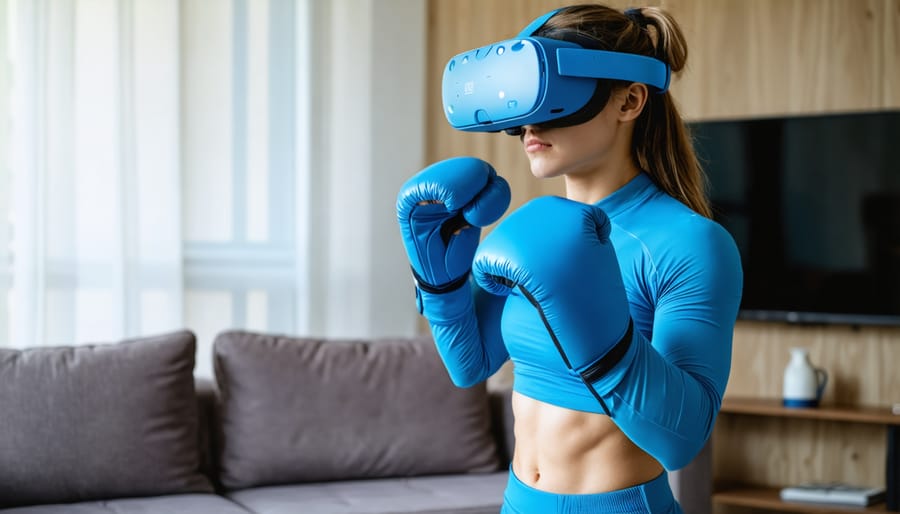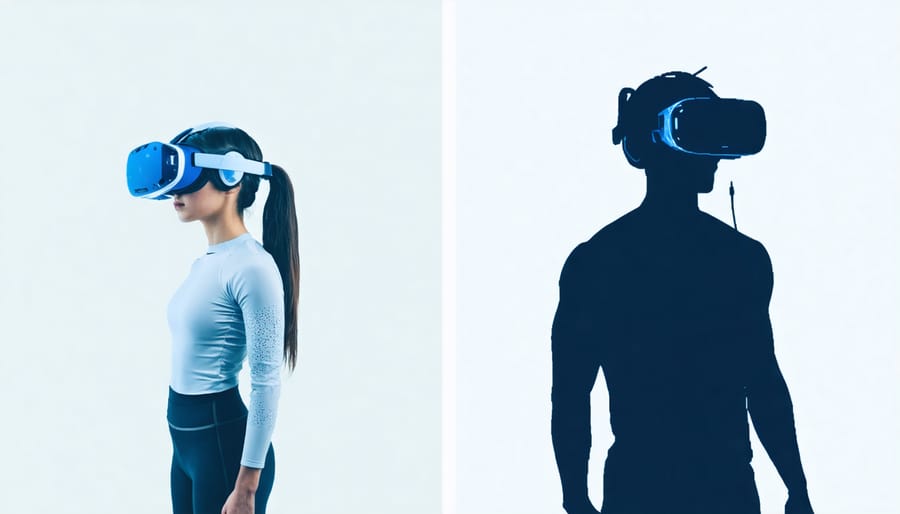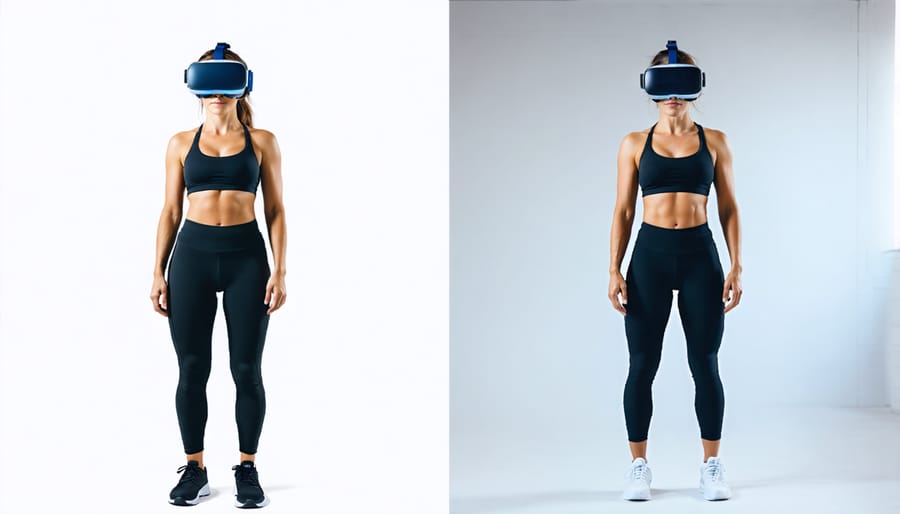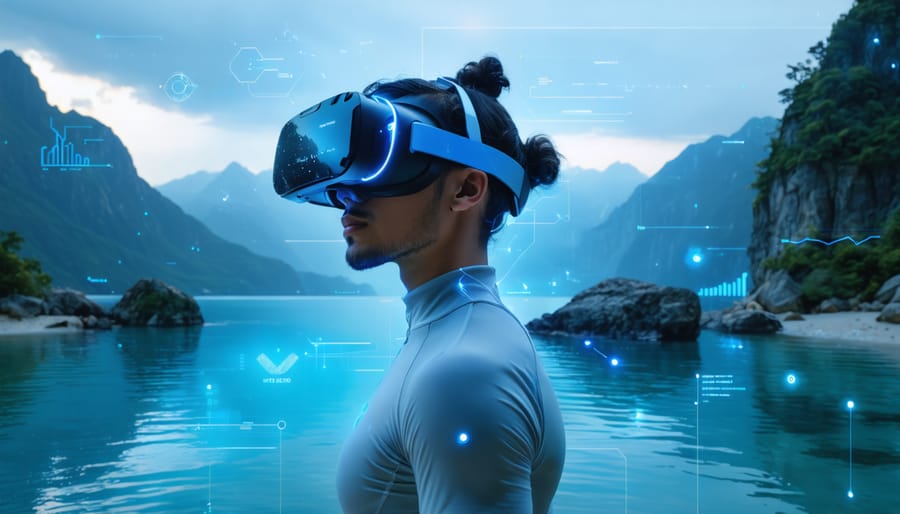Step into the future of fitness where virtual reality meets your daily workout routine. The metaverse is transforming how we exercise, making it possible to attend gym classes in Paris, run through the Swiss Alps, or practice yoga on a pristine beach—all from your living room. This revolutionary blend of technology and physical activity isn’t just another fitness trend; it’s creating an entirely new dimension of interactive, engaging, and measurable workout experiences.
As VR headsets become more affordable and fitness apps more sophisticated, metaverse fitness is emerging as a practical solution for people seeking motivation, variety, and community in their exercise routines. Whether you’re a tech enthusiast looking to enhance your workout experience or someone who finds traditional gyms intimidating, virtual fitness environments offer personalized, gamified workouts that adapt to your skill level while tracking your progress in real-time.
The ability to exercise alongside people from around the globe, compete in virtual challenges, and receive immediate feedback from AI-powered trainers is making fitness more accessible and enjoyable than ever before. This exciting intersection of gaming, social connection, and physical activity is revolutionizing how we think about personal wellness and creating new opportunities for achieving our fitness goals.
What is Metaverse Fitness?

Essential Equipment
To begin your metaverse fitness journey, you’ll need a quality virtual reality (VR) headset as your primary piece of equipment. The Meta Quest 2 and Quest 3 are popular choices for their wireless design and user-friendly interface. These standalone headsets offer excellent motion tracking and don’t require a separate computer to operate.
For enhanced safety and comfort, consider investing in a non-slip exercise mat to maintain stable footing during workouts. A silicone face cover for your VR headset helps manage sweat and makes cleaning easier, while moisture-wicking headbands can prevent sweat from damaging the device.
Additional accessories that improve the experience include controller grips for better hold during intense movements and prescription lens inserts if you wear glasses. Some users also opt for wireless earbuds to enhance audio quality without adding cables.
For certain fitness apps, you might need fitness accessories like resistance bands or small weights to maximize your workout potential. Remember to create enough clear space around you – experts recommend at least 6.5 x 6.5 feet for safe movement during virtual workouts.
Popular Platforms and Apps
Several leading virtual fitness applications are making waves in Canada’s metaverse fitness landscape. Supernatural, available on Meta Quest headsets, offers immersive workouts in stunning virtual environments, from Icelandic glaciers to Moroccan deserts. Users particularly enjoy its boxing, flow, and meditation sessions led by expert coaches.
FitXR has gained popularity among Canadians for its high-energy dance and boxing classes, featuring multiplayer capabilities that allow friends to work out together virtually. The app’s gamified approach helps maintain motivation through achievement systems and social features.
Les Mills Bodycombat VR brings the renowned fitness brand’s signature workouts into virtual reality, offering martial arts-inspired exercises that provide both cardio and strength training benefits. The app tracks progress and adjusts intensity based on individual performance.
Holofit stands out for its integration with traditional cardio equipment, allowing users to run, cycle, or row through virtual environments. The app is compatible with most standard fitness machines, making it an excellent choice for those who want to enhance their home gym experience with immersive technology.
The Science Behind Virtual Workouts

Physical Benefits
Virtual reality fitness delivers impressive physical health benefits, backed by numerous scientific studies. Research shows that VR workouts can burn calories just as effectively as traditional exercises, with users typically burning between 200-400 calories during a 30-minute session. The immersive nature of VR environments helps maintain higher intensity levels throughout workouts, as users often become deeply engaged in their virtual activities.
The dynamic movements required in VR fitness applications engage multiple muscle groups simultaneously, improving overall strength and flexibility. Activities like virtual boxing, dancing, and obstacle courses naturally incorporate full-body movements, promoting better coordination and balance. Many users report enhanced spatial awareness and improved reaction times after regular VR fitness sessions.
Cardiovascular health benefits are particularly noteworthy, with studies indicating that VR workouts can effectively elevate heart rate to target zones for aerobic exercise. The gamification elements encourage users to maintain these elevated activity levels for longer periods compared to traditional exercises, leading to improved endurance and stamina.
Regular VR fitness routines can also contribute to better posture and core strength, as many applications require proper form and balanced movements. The technology’s motion tracking capabilities provide real-time feedback, helping users maintain correct positioning and reduce the risk of exercise-related injuries. For those eyeing muscle growth, you might find understanding what happens on a biological level for muscles to grow insightful in enhancing your VR workouts.
For those with mobility limitations or chronic conditions, VR fitness offers adaptable workout options that can be modified to match individual capabilities while still providing meaningful physical benefits.
Mental Health Impact
The psychological impact of metaverse fitness extends far beyond traditional mental health benefits of exercise. When users immerse themselves in virtual fitness environments, they often experience reduced anxiety and stress levels due to the engaging nature of the experience. The combination of physical movement and virtual escapism creates a unique form of mindfulness, helping participants stay present and focused on their wellness journey.
Many users report feeling more motivated and confident when exercising in the metaverse, as the gamified elements and virtual communities provide constant encouragement and support. The ability to customize avatars and environments allows individuals to exercise in spaces where they feel most comfortable, reducing self-consciousness and social anxiety that might otherwise prevent them from participating in traditional gym settings.
The social aspects of metaverse fitness platforms also contribute significantly to mental well-being. Users can connect with like-minded individuals from across Canada and beyond, forming supportive communities that celebrate achievements and provide accountability. This sense of belonging and connection has proven particularly valuable for those who may feel isolated or struggle with traditional fitness settings.
Regular participation in metaverse fitness activities has been associated with improved mood, better sleep quality, and increased self-esteem, making it an effective tool for supporting overall mental wellness while achieving physical health goals.
Getting Started with Metaverse Fitness
Choosing Your First VR Workout
When starting your VR fitness journey, begin with programs that match your current fitness level and comfort with virtual reality technology. Look for apps that offer tutorial modes and beginner-friendly workouts to help you adjust to moving in virtual space. Popular starter options include rhythm-based games that incorporate simple movements and basic cardio exercises.
Consider the workout space required by different programs. Some VR fitness apps need only enough room to stand and stretch your arms, while others require space to move around. Ensure your chosen program suits your available area and includes safety features like boundary notifications.
Pay attention to intensity levels and workout duration. Start with 10-15 minute sessions to build your “VR legs” and prevent motion sickness. Many apps offer difficulty settings and workout customization options, allowing you to gradually increase intensity as you progress.
Look for programs with clear instruction and form guidance. Good VR fitness apps provide visual cues and verbal coaching to help maintain proper posture and movement patterns. Some even offer progress tracking and achievement systems to keep you motivated.
Finally, read user reviews focusing on comfort, ease of use, and motion smoothness. Choose apps with regular updates and active community support for the best long-term experience. Remember, the most effective VR workout is one you’ll actually enjoy and stick with consistently.
Safety Guidelines
While metaverse fitness offers exciting possibilities, following proper safety guidelines is essential for a secure and enjoyable experience. Start by creating a clear, obstacle-free space of at least 2 meters by 2 meters to prevent accidents during movement. Always perform a safety boundary check in your VR system before beginning your workout.
Following healthy technology practices is crucial when using VR equipment. Limit sessions to 30-45 minutes initially, taking regular breaks to prevent motion sickness and eye strain. Stay hydrated and watch for signs of dizziness or disorientation, which may signal the need for a break.
Proper form remains essential, even in virtual workouts. Start with basic movements and gradually progress to more complex exercises. Ensure your VR headset is properly fitted and secured to prevent slipping during movement. Keep a spotter nearby when trying new or challenging exercises, especially those involving balance.
Monitor room temperature, as VR workouts can be intense, and wear moisture-wicking clothing to stay comfortable. If you have pre-existing health conditions, consult your healthcare provider before starting a VR fitness routine. Remember to warm up properly and cool down after each session, just as you would with traditional exercise.

Real Success Stories
The metaverse has transformed countless lives across Canada, turning virtual workouts into real-world results. Take Sarah Mitchell from Vancouver, who embarked on her fitness transformation journey during the pandemic lockdowns. Using a Meta Quest headset and supernatural VR fitness app, she lost 45 pounds in eight months while managing her anxiety through immersive meditation sessions.
In Toronto, Mark Thompson, a 42-year-old software developer, found his perfect workout solution in VR boxing. “Traditional gyms never clicked with me,” he shares. “But throwing punches at virtual targets while exploring digital landscapes made fitness fun for the first time.” Mark’s consistency with metaverse workouts helped him lower his blood pressure and improve his cardiovascular health significantly.
Montreal-based Emily Tremblay discovered an unexpected social benefit. Through her metaverse fitness community, she connected with workout partners across the country. “We meet three times a week for virtual group classes. The encouragement and accountability have kept me motivated for over a year now,” she explains. Emily has since completed several virtual marathons and improved her overall strength and endurance.
Regina resident David Chen, who struggles with mobility issues, found freedom in virtual reality fitness. “The seated workout options and adaptable difficulty levels made exercise accessible for me,” he reports. After six months of regular metaverse workouts, David noticed significant improvements in his range of motion and daily energy levels.
These success stories highlight how metaverse fitness platforms are breaking down barriers to exercise, creating inclusive communities, and delivering measurable results. Whether it’s weight loss, improved mental health, or enhanced physical capabilities, Canadians are discovering that virtual reality workouts can lead to very real transformations.
As we’ve explored throughout this article, metaverse fitness represents an exciting frontier in the evolution of physical activity and wellness. By combining immersive technology with exercise, it offers a unique solution for Canadians looking to stay active, particularly during our long winter months or when accessing traditional gyms isn’t practical.
The potential benefits are compelling: enhanced motivation through gamification, social connections across distances, personalized workout experiences, and the ability to exercise in virtually any environment you choose. Whether you’re a fitness enthusiast or someone just starting their wellness journey, metaverse fitness can adapt to your needs and preferences.
While the technology may seem intimidating at first, getting started is simpler than you might think. With basic VR equipment and a comfortable space at home, you can begin exploring this innovative approach to fitness. Remember to start gradually, listen to your body, and choose applications that match your fitness level and interests.
As this technology continues to evolve, we can expect even more engaging and effective ways to pursue our health goals. Why not take the first step into metaverse fitness today? Your virtual wellness journey could open up new possibilities for achieving your fitness objectives while having fun in the process. The future of fitness is here, and it’s more accessible and engaging than ever before.

